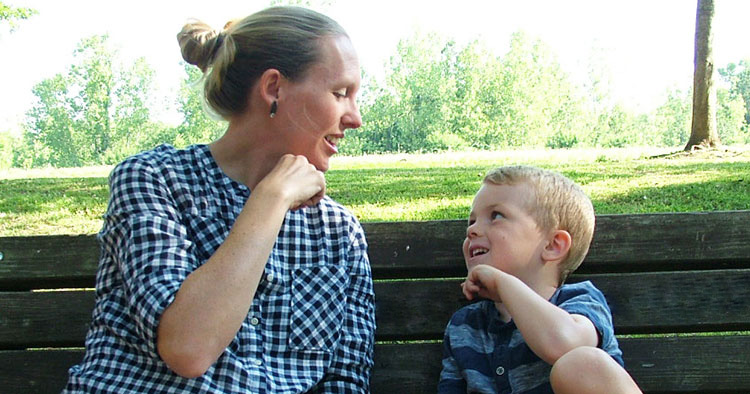E3: Feeling Syllables
1. Overview
Feel how your mouth moves with each syllable of a word. This is your child’s introduction to the concept of syllables and how words can be analyzed and broken into parts. In words with multiple syllables, some of the individual syllables have no meaning, so your child has probably never noticed them before. For example: in the two-syllable word marching, the -ing syllable has no meaning on its own. This activity will teach your child to divide words into the rhythmic speech segments known as syllables.Syllables are the “natural perforations in words,” the places where words easily come apart.We will begin this section by focusing on compound words, where each syllable has a meaning on its own. For example, starfish is made up of the words/syllables star and fish. This will ease the child into the concept of syllables.

Hold two fingers underneath your chin as you speak to show your child the best technique for feeling the syllables in words.
2. Materials
↑ Top3. Activity
Explain to your child what a syllable is. It is one part of a word. Pronounce these words slowly and very clearly, giving equal weight to each syllable.Video: How to play Feeling Syllables
You will model holding two fingers parallel to and touching under your chin while slowly saying the word. Then help the child hold her fingers firmly under her own chin. It is important that the child feel her chin move when uttering each syllable.
Adult: You’ve learned about some long words and some short words. You can tell how long most words are by counting how many parts they have. Listen: rain – bow. [Hold two fingers under your chin while saying word.] Watch how my chin moves with each word part: rain – bow. Hold your fingers under your chin, like this. Now say the word with me: rain – bow. Child & Adult: rain – bow. Adult: Good! Each of those word parts is called a syllable. Can you say syllable? Child: Syllable. Adult: Yes. Now we are going to count the syllables, or parts, in different words. Some words are short, and they have only one part. These are words like dog, fish, and book. [Hold two fingers under your chin while saying word.] Other words are a little longer, and they have two parts: dog-house, gold-fish, book-bag. [Hold two fingers under your chin while saying word.] Longer words have three parts: e-le-phant, um-brel-la. [Hold two fingers under your chin while saying word.] And some words even have four parts: te-le-vi-sion, rhi-no-cer-os! [Hold two fingers under your chin while saying word.]Now have the child join you in saying some compound words and feeling how her chin moves with each syllable.
Adult: Hold your fingers under your chin. Now say cow-boy. Child: Cow-boy. Adult: This time, say cowboy and count how many times your chin moves. Ready? Child: Cow-boy. Two! Adult: Yes. Cowboy is a word that has two parts, two syllables.Once your child has the hang of feeling the syllables and understanding the difference between one-syllable and two-syllable words, move on to three-syllable words, and then a few four-syllable words. Stick with this activity until the child has firmly mastered this skill. This is a tremendously valuable technique that will be useful throughout preschool and beyond. ↑ Top
4. Confidence Builder
If the child has difficulty counting her chin drops, have her put her whole fist under the tip of her chin and you count aloud each time her chin drops. Then, have her repeat the word after you and have her try to count the number of times she feels her chin drop. Some children find it easier to use their fist instead of their fingers to feel the syllables in words they say.5. Variation
This game can be played anywhere, as it doesn’t require any picture cards or props. Help your child practice feeling syllables while you are waiting in line, in the car, etc. ↑ Top6. Small Groups (2-5 children)
Lesson Objective: Children will feel and correctly count the number of syllables in a spoken word by holding together their index and middle fingers of one hand firmly under their chin while orally repeating the word. GELDS (Georgia Early Learning & Development Standards): CLL6.4e Georgia Standards of Excellence: ELAGSEKRF2.b Common Core State Standards: CCSS.ELA-LITERACY.RF.K.2.B Adaptation: Read the main activity, watch the video, and follow the instructions above, with the following changes: Read words from the word list as the children count the syllables aloud as a group. When they have had several opportunities to practice, ask for volunteers to demonstrate “feeling” the syllables while the other children count aloud the number of syllables they hear. Have the children then check their answer by feeling the syllables as they repeat the volunteer’s spoken word. Reinforcement: “Look around the classroom. Let’s find new words to “feel” and count the syllables.” Use this Reinforcement at Home form to tell parents and guardians how they can reinforce lessons outside the classroom. ↑ Top7. Frequently Asked Questions
Q: Why do children need to feel the syllables, instead of just hearing them? A: A young child’s auditory system is actually not yet developed enough to hear separate syllables and sounds in the same way that adults do. So children need to feel the chin movements to understand what syllables are. Q: My child has cerebral palsy and can’t hold her fingers straight. How can she do this activity? A: If your child can’t feel the chin movements with her fingers, she can use another body part — the back of her hand, her wrist, or her forearm — so long as she can hold it firmly under her chin to feel how her jaw moves with each syllable. ↑ TopLeave a Reply
